
Code_Aster
®
Version
7.4
Titrate:
Interface access to Code_Aster: astk
Date:
05/04/05
Author (S):
COURTEOUS Mr.
Key
:
U1.04.00-C
Page
:
1/34
Instruction manual
U1.0- booklet: Introduction to Code_Aster
HT-66/05/004/A
Organization (S):
EDF-R & D/AMA
Instruction manual
U1.0- booklet: Introduction to Code_Aster
Document: U1.04.00
Interface access to Code_Aster: astk
Summary:
This document presents astk (contraction of Aster and Tk, to pronounce “astek”), the interface making it possible to organize
its calculations Aster.
One describes the logic of operation of astk, the graphic interface itself, bsf which makes it possible to explore them
files on the various servers, then it is explained how the user can configure astk according to
its needs.
Lastly, on a concrete example, one shows how to use astk to make a study, an overload, to launch one
list case-tests.
For the people having access to the server of calculation Aster of network EDF, one explains how to reach
cards of experience feedback (REX), and, developer, tool of the AGLA (data processing department
Aster).
The functionalities of astk version 1.2 are described here which supports versions 6 (starting from the STA6.5), 7 and 8
of Code_Aster.
Version 5 is not supported by astk.

Code_Aster
®
Version
7.4
Titrate:
Interface access to Code_Aster: astk
Date:
05/04/05
Author (S):
COURTEOUS Mr.
Key
:
U1.04.00-C
Page
:
2/34
Instruction manual
U1.0- booklet: Introduction to Code_Aster
HT-66/05/004/A
Count
matters

Code_Aster
®
Version
7.4
Titrate:
Interface access to Code_Aster: astk
Date:
05/04/05
Author (S):
COURTEOUS Mr.
Key
:
U1.04.00-C
Page
:
3/34
Instruction manual
U1.0- booklet: Introduction to Code_Aster
HT-66/05/004/A

Code_Aster
®
Version
7.4
Titrate:
Interface access to Code_Aster: astk
Date:
05/04/05
Author (S):
COURTEOUS Mr.
Key
:
U1.04.00-C
Page
:
4/34
Instruction manual
U1.0- booklet: Introduction to Code_Aster
HT-66/05/004/A
1
General presentation and concepts
The provision of a tool as Code_Aster which functions on multiple platforms
require a graphic interface to simplify the work of the user.
In addition, the evolution of the centralized means of calculation and the dissemination into free of Code_Aster have
need the development of a portable product whose architecture can adapt to different
computer set-ups.
astk is the graphic interface which makes it possible to organize its Aster calculations: to prepare its data,
to organize the files, to reach the tools the pre one and postprocessing, to launch and follow the evolution of
calculations. astk also makes it possible to choose the version of Code_Aster to be used among those available
(STA, NEW…). Only versions 6 and following are supported by astk.
The name “astk”, to pronounce “astek”, comes from the contraction from Aster and Tk which is the bookstore
graphics used (as asterix was resulting from Aster and X for X Windows).
1.1 Starting
To launch the interface, it is enough to type in a terminal: astk
In general, the control was placed in the path by defect of the users, the interface opens
with a configuration by defect (see [§ 4] Configuration).
If the control is not found, it is necessary to launch: [to install_dir]/ASTK_CLIENT/bin/astk where
[to install_dir] is the index of installation of astk (contact possibly your administrator).
Access to the server of calculation Aster (EDF and people receiving benefits)
On the server of calculation Aster of EDF, to use the control/aster/tools/astk.
It is advised with units EDF to install the interface on a departmental server.
1.2 Functionalities
STUDY: astk makes it possible to launch an Aster calculation on the local machine (for example within the framework of one
use on micro-computer), a server of departmental calculation or of course the server of
calculation Aster of EDF-R & D (access restricted to EDF and its people receiving benefits of studies).
OVERLOAD: The dissemination of the source code of Code_Aster authorizes each one to test its clean
developments. astk makes it possible “to overload” the code, i.e. to add or modify files
sources, to create a particular version and to use it on case-tests or for studies. One can
thus to create and use the new executable ones, catalogs of controls or elements, and modules
python.
TESTS: It is often judicious to test that its own developments do not impact the code
in addition; astk makes it possible to easily launch a list of case-tests with a personal version.
AGLA: To the developers of the version of reference EDF, astk offers the access to the data processing department
Aster, AGLA, which makes it possible to organize the collaboratif development of the version of development
(to avoid the conflicts, to ensure nonthe regression…).
REX: To make live the code passes by the taking into account of the remarks, needs, opinions of the users.
Cards of experience feedback can be emitted and consulted by the users since
the interface, the developers can answer it (access to necessary server EDF).

Code_Aster
®
Version
7.4
Titrate:
Interface access to Code_Aster: astk
Date:
05/04/05
Author (S):
COURTEOUS Mr.
Key
:
U1.04.00-C
Page
:
5/34
Instruction manual
U1.0- booklet: Introduction to Code_Aster
HT-66/05/004/A
MULTI-MACHINES: Files necessary to its various actions (files of mesh, source,
results…) can be distributed on various machines on the network (declared in astk), astk
ensuring the transfer and compression/decompression.
The passage of a firebreak is not proposed.
TOOLS: The user can launch various predefined tools and configure those which it needs
(maillor, tool for postprocessing, editor…).
BSF: A navigator is provided (called bsf, box of selection of files), it allows to traverse them
filing systems of the definite distant machines and to carry out current operations on
files: copy, suppression, renaming, impression, or to open a window of
controls on these machines.
ASJOB: One can follow calculations, their state (in particular in the case of launching in batch) since
the window “Followed by the jobs”, also called asjob.
1.3
Operating mode
Architecture client/server authorizes a clear separation between the interface (customer) and the tools used
to reach the code (services). It makes it possible to use the whole of scripts of the AGLA to manage
version of reference in batch and as_run (cf Appendix 1), a service astk, for the other versions
available in room or on the network.
The communications protocol between the various machines is rsh or HS for the controls
Shell and CCP, SCP or rsync for the copy of files.
Example: The customer (i.e. the interface launched by the control astk) request launching
of a calculation on a server of calculation.
The interface carries out a service on the server in question (control rsh or HS) by indicating them to him
parameters necessary to calculation (contained in a profile, to see [§ 1.5]). The service takes then in
charge the operations necessary: to repatriate the files necessary to the calculation of different
machines towards the server of calculation, launching of calculation, return of the files results…
1.4 Servers
astk
For astk, a server is:
· that is to say a server of calculation Aster: a machine on which one can find the part “server” of
astk, i.e. the whole of the services which give access the code; one will be able to launch
calculations via this server and to use files on this server for a calculation,
· that is to say a file server: one will be able simply to use files on this server at the time of one
calculation.
The server called “Room” is in fact a file server (only information of connection are
necessary for a file server, but on the local machine, one knows them easily).
If one wishes to launch calculations on the local machine (on which are installed a version of Aster
and the server part of astk), it is also necessary to declare this machine like a server of calculation (Local and
Machine in the following example).

Code_Aster
®
Version
7.4
Titrate:
Interface access to Code_Aster: astk
Date:
05/04/05
Author (S):
COURTEOUS Mr.
Key
:
U1.04.00-C
Page
:
6/34
Instruction manual
U1.0- booklet: Introduction to Code_Aster
HT-66/05/004/A
astk is used on the machine of name mach00, on which Code_Aster is installed. One has access to
a departmental file server file01, the files of this server is accessible
(assembly NFS) since two machines of calculation comp02, comp03. One has also access to a cluster
with NR nodes of calculation whose frontal machine is front04.
One has then:
· “Local” (reserved label): one has it always to explore the files which are on
mach00;
· “Machine” (label unspecified, the procedure of installation fixes this name at the value
turned over by the control `uname N `): whose address IP is that of mach00 which is
the server of calculation (services astk installed) of the local machine;
· “Departure” (unspecified label): whose address IP is that of file01, which allows
to explore the files lodged by the file server, configured like a server of
calculation Aster (services astk installed) having comp02 and comp03 seen like nodes of
calculation (comp0i can be the same machine as file01);
· “Cluster” (unspecified label): whose address IP is that of front04 which is a server
of calculation (services astk installed) having NR nodes, the only machine accessible being
front04.
The difference between “Departure” and “Cluster” is that in general the stations of calculation are
accessible directly (one could thus subject a calculation in interactive on one or the other),
whereas for a cluster, the users see only the frontal machine in general,
distribution being made on the nodes by a sequencer of batch processings.
One can as well have several servers of calculation “Departure” or “Cluster” that not to have
only the post “Local+Machine”.
1.5 Profile
astk
A profile astk is a file which contains all information relating to your study, your overload,
etc: the site of the files of the study, in data, result, the type associated with each file,
parameters of tender of calculation (memory, time, machine of calculation, interactive batch/…), in
case of overload, the site of the source files, executable, the catalogs produced…
The profile also contains parameters on the interface itself to resume a study
exactly in the same state that it had been left.
The profile is recorded on request of the user (finely Fichier/Enregistrer or To record under…) and
with each launching of a calculation.
For the users of asterix: the profile astk includes the profile of study and execution to the direction asterix, and
the parameters of tender which were not stored in asterix. The file, even if it remains with
ASCII format, is despite everything more intricate to read.
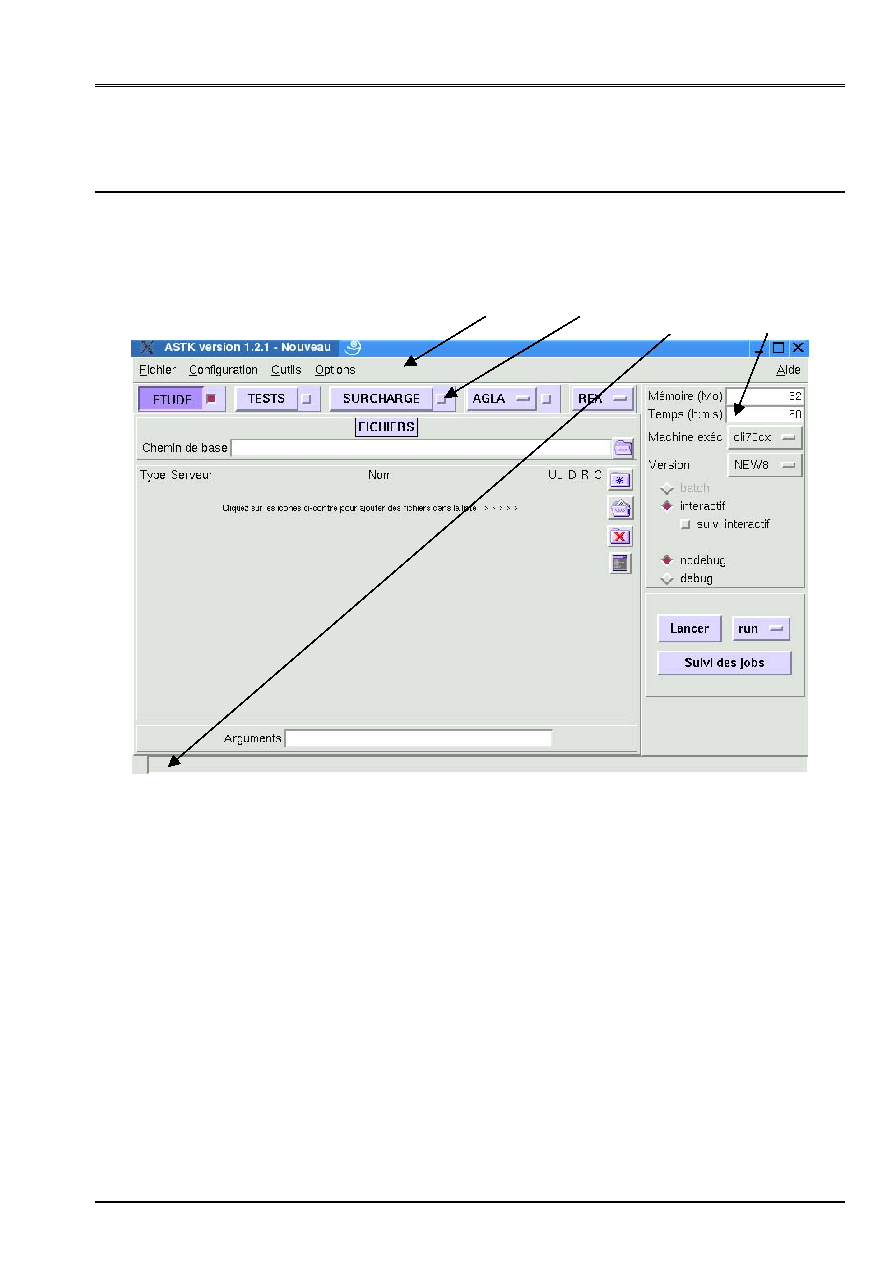
Code_Aster
®
Version
7.4
Titrate:
Interface access to Code_Aster: astk
Date:
05/04/05
Author (S):
COURTEOUS Mr.
Key
:
U1.04.00-C
Page
:
7/34
Instruction manual
U1.0- booklet: Introduction to Code_Aster
HT-66/05/004/A
2
Description of the graphic interface
The graphic interface (IHM) breaks up into 4 parts:
1) A bar of menu
2)
miters
3) Parameters of tenders
4) The bar of state
2.1
Bar of menu
The menu “Aid” also makes it possible to reach the description of the menus.
2.1.1 Menu
File
· New: Allows to create a new profile.
· To open: Open a profile created before by astk. One cannot open the profiles created by
asterix in this way.
· To record: Back up the profile running (this is made automatically during the launching of one
calculation).
· To record under: Back up the profile running while giving the choice of the name of the profile and sound
site.
2.
1.
3.
4.

Code_Aster
®
Version
7.4
Titrate:
Interface access to Code_Aster: astk
Date:
05/04/05
Author (S):
COURTEOUS Mr.
Key
:
U1.04.00-C
Page
:
8/34
Instruction manual
U1.0- booklet: Introduction to Code_Aster
HT-66/05/004/A
· To copy under: Copy the profile running in another index and proposes to copy the files (in
data and/or results) that it reference.
· To import:
- asterix: Reads again a file .prêt or .prex produces by asterix (the contents of the .prêt being less rich,
reworks will be probably necessary, to consult INFORMATION).
- astk_serv: Reads again a file .export of a preceding execution (or the file * .pNNN of
index $HOME/flashor).
· To export under: Allows to export the profile running to the format astk_serv (for the services
ASTK_SERV).
· Impression: Configuration of the controls of impression
The user defines controls of impression (lpr, a2ps…) who will be used to print
files, and files of impression (printing). The control can be carried out on one
distant server.
For the code @P of the line of control the name of the file of impression will be substituted, the name of
file will replace @F (see [§ 2.1.3] for the field codes).
Example of ordering of impression:
lpr - H - P @P @F
or/usr/bin/a2ps - P @P - 2 --print-anyway=yes --sides=tumble @F
· To leave: Finish the session
· The NR the last open profiles are directly accessible starting from small Fichier.
2.1.2 Menu
Configuration
· Servers: Allows to modify the configuration of the servers: servers of calculation or servers of
file.
- For the servers of calculation, to choose the mode of downloading of the configuration Aster:
server turns over the list of the versions available, the procedure (batch and/or interactive)
and associated limits.
It is necessary to indicate the “login” authorized to connect itself to the server, and the index where is installed
server part of astk (ASTK_SERV).
- For the file servers, to choose “any” like mode downloading of
configuration Aster.
· Interface: Defines the preferences of the user:
For astk:
Name, first name, email will be used for the link towards the management tool of the experience feedback
(emission, consultation of the cards faults, evolution…).
The access to the functions of the data processing department Aster if the user is recognized as
developer Aster on the machine of reference.
The access path to the editor and the terminal (window xterm) on the local machine, the version with
to select by defect, the number of remanent profiles in the small File, the level of
message (debug), the domain name network of the machine and if mode DHCP (addresses IP
dynamics) is active, the communications protocols used for the controls Shell (rsh
or HS) and copies it files (CCP, SCP or rsync).
For the follow-up of the jobs:
The number of lines displayed during the consultation of a calculation in the course of execution (tail), and
the automatic frequency of updating in minutes.

Code_Aster
®
Version
7.4
Titrate:
Interface access to Code_Aster: astk
Date:
05/04/05
Author (S):
COURTEOUS Mr.
Key
:
U1.04.00-C
Page
:
9/34
Instruction manual
U1.0- booklet: Introduction to Code_Aster
HT-66/05/004/A
2.1.3 Menu
Tools
· Parameters: Allows to configure the launching of the tools.
Certain tools are envisaged out of standard (without inevitably being available on the local machine):
- bsf: Browser of files multi-machines,
- Eficas: Editor of command file Aster,
- Gibi: Maillor and tool for postprocessing (usable free with Aster),
- GMSH: Maillor and tool for postprocessing (free),
- Stanley: Tool for postprocessing integrated into Aster,
- Foresys: Tool for navigation in sources FORTRAN.
When one chooses Stanley throw, astk seeks in the profile the bases available (by command
preferably a base in result, if there is not, a bhdf (HDF bases) in result, if not one
base in data and finally, a bhdf in data), produces a temporary profile starting from the profile
running with a command file Aster which starts with CONTINUATION () and which launches
STANLEY ().
The user can add his own tools, to parameterize the access path to the tools (including
to modify the ordering of access to the standard tools), to define in which types of files associate
the tool and to specify if one can use the tool on a distant file.
The following codes can be used in the line of control:
- @F: absolute path of the selected file,
- @R: index containing the selected file,
- @f: name of the file (without the index),
- @D: address DISPLAY (that known at the time of the launching of the interface).
The tools are called either starting from small Outils, or starting from the contextual menu on a file
of a list or in the browser (right button).
To select a file, it is enough to click on its name in a list (in the Etude miter,
Tests or Overload).
While double-clicking on a file, association between the type of the file and the tool to be used rest on
extension of the file name for the bsf, whereas the type selected by the drop-down list (cf.
description of the miters) prevails in astk.
2.1.4 Menu
Options
· Arguments:
Allows to position optional arguments which will have placed on the line of order of
execution of Code_Aster.
dbgjeveux: activate a mode different from the management of the objects in memory to detect them
crushings and destruction of objects,
rep_outils: the index defines where the tools called since Aster (onmetis are sought or
gibi for example),
rep_dex: the index defines where are sought the external data (given mesh),
rep_mat: the index defines where the data of the catalog material are stored.
· Parameters:
Definition of the optional parameters used during the launching of a list of tests (button
TESTS).
nbmaxnook: a maximum number of invalid case-tests (NOOK, ARRET_ANORMAL…) before the stop
list of the tests,
cpresok: allows to choose which are the tests of which one keeps the files result,
RESOK: one keeps the files of tests OK and NOOK,
RESNOOK: one keeps only the files of tests NOOK,
facmtps: multiplicative factor of the time of the tests (compared to the time of reference of will.para).
Useful, for example, when one subjects tests with executable built in debug mode, more
slow.
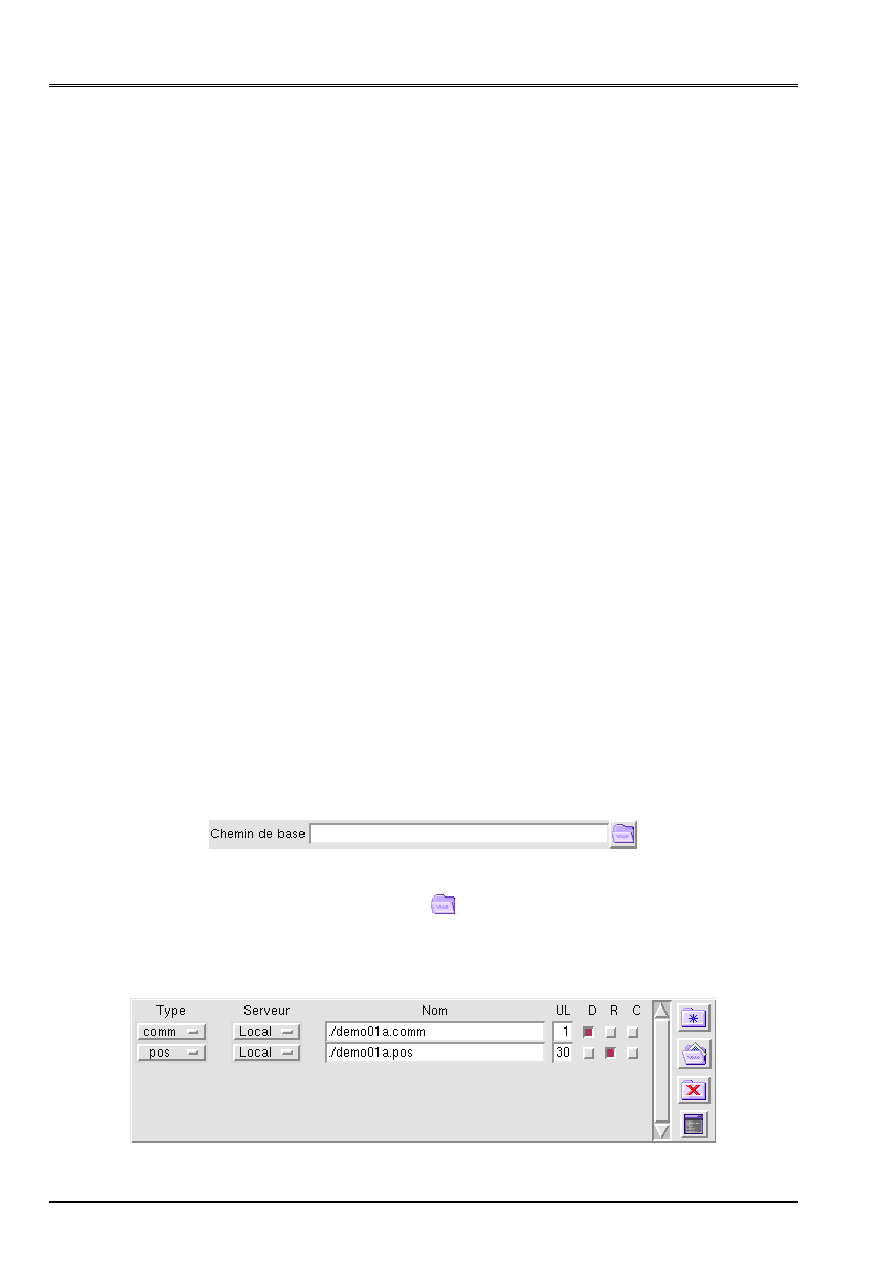
Code_Aster
®
Version
7.4
Titrate:
Interface access to Code_Aster: astk
Date:
05/04/05
Author (S):
COURTEOUS Mr.
Key
:
U1.04.00-C
Page
:
10/34
Instruction manual
U1.0- booklet: Introduction to Code_Aster
HT-66/05/004/A
2.1.5 Menu
Help
· Introduction/Small Parameters of calculation/: access to the text of aid
· History of the amendments: Evolution of astk to the wire of the versions, new possibilities,
corrections carried out, known faults…
· Frequent problems: Some questions frequently put with their solutions.
· Fenestrate messages: The messages of information <INFO>, of <ERREUR> errors are written
in this window. With a level of message equal to or higher than 1 (see [§ 2.1.2]), one obtains
more or less of information.
Level 3 displays the controls subjected to the servers, levels 4 and 5 make it possible to have
complementary details in the file .o (of debug type) during the execution of as_run (in
interactive); what makes it possible to include/understand sometimes why an error occurs.
· By the way: the impossible to circumvent window of information.
2.2
miters
One finds five buttons in this area. One speaks about miter because the contents which one finds under
the buttons changes according to that which is in a hurry. Graphically, they are not “truths” miters bus
the widget does not exist in standard the Tk bookstore (and one did not want to add pre-necessary
additional!).
STUDY, TESTS and OVERLOAD are miters in which one informs the list of the files
necessary; AGLA and REX are buttons which can use the contents of the other miters.
Lastly, the check box located beside the first four buttons announces that one uses (or not) it
contents of the associated miter.
Examples: To launch a study, the miter STUDY should be notched. To call upon the functions of
the AGLA (on the machine of reference), miter AGLA should be notched; one will note that in this case, TESTS
and OVERLOAD are automatically notched because their contents are taken into account.
2.2.1 Miters STUDY, TESTS, OVERLOAD
To reach the files more easily, to traverse the tree structures more quickly (files
being often gathered in close indices), or to simplify the display of the names of
files, one can define a basic path.
One defines it while clicking on the Parcourir button
and one chooses the index which will be the index by
defect.
Each miter contains a list of files (two lists for OVERLOAD).

Code_Aster
®
Version
7.4
Titrate:
Interface access to Code_Aster: astk
Date:
05/04/05
Author (S):
COURTEOUS Mr.
Key
:
U1.04.00-C
Page
:
11/34
Instruction manual
U1.0- booklet: Introduction to Code_Aster
HT-66/05/004/A
One defines a file or index by line. One finds left towards the line:
· Type: type of the file or the index;
· Server: name of the server on which is the file/index;
· Name: access path to the file: in absolute if it starts with “/”, into relative compared to
basic path in the contrary case;
· UL: logical number of unit associated this file;
· D, R, C: check boxs to indicate if the file/index is respectively in data,
result, compressed (with gzip).
When one changes the type of a file/index, default values are positioned for
indicators D, R, C and the logical number of unit.
Notice on the types:
Code_Aster handles the files via the procedures FORTRAN which use numbers
of logical unit (file fort.19 for example); it thus affects numbers of unit
logic by defect to simplify the life of the user. The “type” thus makes it possible to reach
easily with the numbers used by defect; it as makes it possible astk to check as
the user provides coherent data (for example which one provides well one
index for such type, or which one does not provide two objects whereas only one is
authorized for such other…).
To handle the list, one has four buttons:
·
: allows to add a new virgin input at the end of the list;
·
: allows to add a file/index at the end of the list by traversing the tree structure of
files;
·
: to remove the line currently selected in the list;
·
: open the file/index currently selected in the list with the editor of the server
Arguments (miter STUDY and TESTS only):
This area of text makes it possible to transmit arguments to executable Aster. See also [§2.1.4].
Finely contextual:
While clicking with the right button on an input of the list, one reaches a contextual menu:
· To open: launch the tool associated with this type of file (determined by the “Standard” field, and not
the extension of the file), if no tool is associated this type, one publishes the file;
· To publish: publish the file (or all the files of the index) in the same way as it
button
;
· To print: print the selected file;
· To open with…: one can choose to open the file selected with one of the tools available
(the result can be astonishing if the tool does not know this type of file!) ;
· Default values: the interface determines a file name per defect according to
“Standard” selected starting from the name of the profile (file .astk), no value is proposed if
the profile was recorded yet (is used in general on a virgin line only one
has just inserted, the indicators D/R/C are not affected by this operation);
· Properties: display the permissions, the size, the date and the hour of the file (control ls -
).
Miter OVERLOADS
The data (source files) are provided in the higher list, whereas them
results (executable, catalogs compiled) are provided in the lower list.

Code_Aster
®
Version
7.4
Titrate:
Interface access to Code_Aster: astk
Date:
05/04/05
Author (S):
COURTEOUS Mr.
Key
:
U1.04.00-C
Page
:
12/34
Instruction manual
U1.0- booklet: Introduction to Code_Aster
HT-66/05/004/A
2.2.1.1 List types for STUDY
COM:
command files Aster (including the files of continuation)
mall:
file mesh with the format Aster
wander:
file of error (fort.9 of Aster)
mess:
file of the messages of the execution
resu:
file of result (impression of the tests, impression to the format Aster)
base:
index containing the base of calculation
bhdf
index containing the base of calculation to format HDF
cast:
file result with format CASTEM
mast:
kept for reason compatibility
mgib:
mesh with the Gibi format
mmed:
mesh with format MED
msh:
mesh with the Gmsh format
msup:
mesh with format IDEAS
pos:
file result with the Gmsh format
ensi:
index result with the Ensight format
dat:
file result containing of the curves to format XMGRACE
PS:
File postscript
agraf:
file result containing the data for Agraf (old versions of Aster
wrote the directives and the data in the same file that it was necessary to cut out with
the control post_agraf on the machine of reference)
digr:
file result containing the directives for Agraf
rmed:
file result with format MED
unv:
file result with the “Universal” format (IDEAS)
para:
file of parameters (retranscription of the parameters of calculation for the tests)
repe:
result and/or data directory (makes it possible to transmit/recover the contents
complete of an index; as one does not affect numbers of logical unit Aster
must reach the files by their names, cf orders DEFI_FICHIER)
libr:
file or index with the choice of the user
btc:
script of launching generated by the service (one can thus recover it, to modify it…).
At the time of a astout on the machine of reference, resu_test must be on the aforementioned.
2.2.1.2 List types for TESTS
list:
file containing the list of the tests to be carried out (a name of test per line without .comm)
rep_test:
index containing the data files of the tests (controls, mesh…)
resu_test:
index where the files results are recopied
btc:
idem STUDY
2.2.1.3 List types for OVERLOAD, part GIVEN
F:
sources FORTRAN
C:
sources C
py:
python sources
capy:
sources of the catalogs of controls
cata:
sources of the catalogs of elements, options, sizes…
hist:
file histor (historical of the amendments)
conf:
file of configuration (choice of the options of compilation, the bookstores…)
unig:
file unigest containing the modules to be removed
datg:
geometrical data
cmat:
catalogs of data materials
In general, one provides an index for the first five types (sources); all the files of which
the extension corresponds to the type indicated are taken into account. Nevertheless, it is disadvised mixing
types of files in the same index.
hist, unig, datg and cmat are exclusively related to the management of the version of reference.
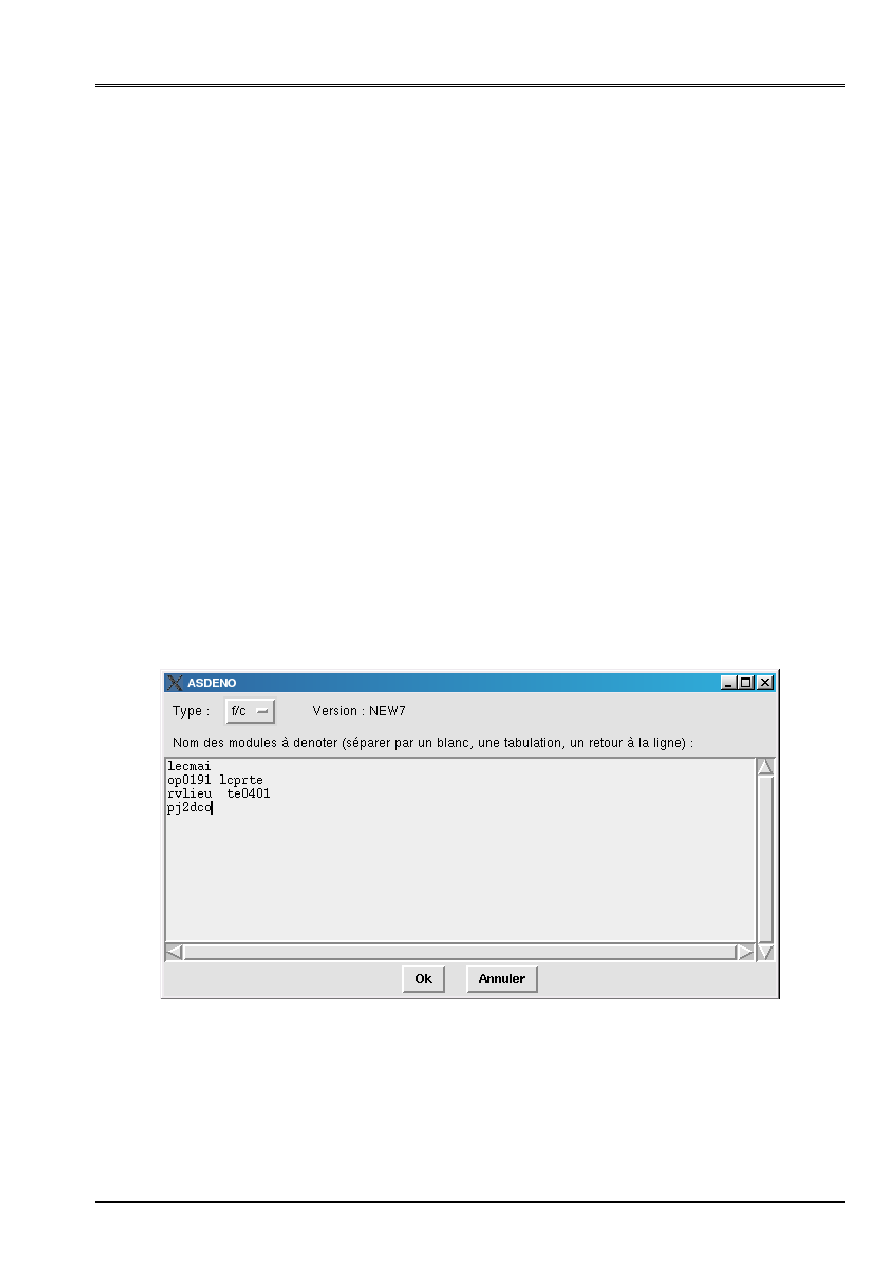
Code_Aster
®
Version
7.4
Titrate:
Interface access to Code_Aster: astk
Date:
05/04/05
Author (S):
COURTEOUS Mr.
Key
:
U1.04.00-C
Page
:
13/34
Instruction manual
U1.0- booklet: Introduction to Code_Aster
HT-66/05/004/A
2.2.1.4 List types for OVERLOAD, RESULTS part
exec:
file of the executable Aster
cmde:
index of the catalog of control compiled
it:
file of the catalog of elements
forlib:
bookstore for FORESYS
btc:
idem STUDY
forlib is used only on the machine of reference.
2.2.2 Button
AGLA
This button gives access the functions of the data processing department which coordinates the actions of
developers of the version of coherence. For that, the box on the right of the button must be notched, it
who causes automatically to take into account the contents of the miters TESTS and
OVERLOAD, it is then enough to click on the button “Throw”.
One will refer to the manual of the AGLA ([D1.02.01]) for more details on the various actions.
· ASNO: allows “to note” modules (to announce that one envisages to restore one
amendment), applies to the source files and the files of test.
· ASDENO: allows “to indicate” modules. This action does not use any the data of
TESTS or OVERLOAD. When one clicks on “Launching”, a window requires to choose
the type of module to be indicated (FORTRAN/C, python, catalogs or test), and to indicate the name of
modules separated by a space, a tabulation or a return to the line (without the extension:
op0191 to indicate the file op0191.f). For the files Python, it is necessary of
to specify the name of the index (package in the denomination Python) in which they
find (bus contrary to sources FORTRAN and C, the same name can be used in
different indices), example
: macr_recal_ops@Macro (indicates the module
macr_recal_ops of the Macro package).
· ASQUIT: provides in the file output the list of all the noted modules.
· ASVERIF: check that a whole of sources can be integrated in the version of reference
(compliance with the rules of programming, file histor present…).
· PRE_EDA: it must be carried out before the meeting of the team of development, the developer
thus announce its intention to restore sources, PRE_EDA raises the points which will have
to be regulated in meeting of development (PRE_EDA carries out a ASVERIF and a passage of
tests provided in the profile).

Code_Aster
®
Version
7.4
Titrate:
Interface access to Code_Aster: astk
Date:
05/04/05
Author (S):
COURTEOUS Mr.
Key
:
U1.04.00-C
Page
:
14/34
Instruction manual
U1.0- booklet: Introduction to Code_Aster
HT-66/05/004/A
· ASREST: it is about the ultimate phase of the restitution which consists of a ASVERIF, one
passage of the tests of the list of nonregression, the code return must be lower or equal to 2
so that the restitution is taken into account.
· FORLIB creation/suppression: allows to produce/remove a bookstore for the tool
FORESYS (on the machine of reference).
2.2.3 Button
REX
Notice
This part will be deeply modified during 2005 with the change of the tool
of management of the experience feedback.
This button gives access the management tool of experience feedback (on the machine of reference). It
is decontaminated when the machine of reference is not in the list of the servers.
· Choice of the agent: The user must choose his Aster agent among those which him
are proposed. The Aster agent validates the cards emitted by his front users
that they are examined by the team of development (it filters the problems thus already
known or solved…). The developers are their characteristic corresponding, for them, this choice of
small is thus decontaminated (see also [§ 2.1.2]).
· To emit a card without joining the profile: This function makes it possible the user to emit one
card-index experience feedback to report a fault in Code_Aster (Al: fault
software), to ask for an evolution of Code_Aster (EL: evolution software), in one of the tools
associated (Mongrel, Lobster, Eficas, astk, bsf…) (AO: fault tool/EO: evolution tool), one
amendment of documentation (ED: evolution documentation), or a request for expertise
in modeling (AOM: contribute to the optimization of modeling).
· Information relating to the transmitter of the card is accessible by the menu
Configuration/Interface. The files contained in the profile running are not joined to
card-index, which can make very difficult the processing of the card. It is advised to use “to emit
a card and to associate the files it ".
· The version of Code_Aster indicated is that selected in the interface (Parameters of
calculation).
· To emit a card and to associate the files it: This function makes it possible to emit the same type
of card that the preceding one, this time the data included in the profile are joined to
card-index. For a fault, the files to reproduce the error should always be provided.
· What does not prevent the user from trying to insulate as much as possible the problem
met, in particular to try to join a study on a model which requires little of
memory and of calculating time!
· To consult the cards: The window of consultation of the cards comprises a line where one defines
search keys, the filter makes it possible to carry out a search in the text of the cards
(can be rather long) by using a regular expression.
· “To seek”: the list of the cards refreshes;
· “To visualize”: open the cards selected in the list (one can also double-click
on a card to visualize it);
· “To print”: print the contents cards selected in the list;
· “Associated Files”: if the selected card has associated files, this opens a bsf where
these files are;
· “Associated Study”: if the selected card has associated files, this makes it possible to import
directly profile associated with the card;
· “To print the list”: print the list of the displayed cards.
· Cards to be corrected: For the developers only. One finds the same window of
consultation of the cards with predefined criteria which correspond to the cards that it
developer must treat. An additional button “final Answer” allows him
to answer the card (after having submitted it to the team of development).
· To remove a card: Allows to remove a card which is still in the state
EMIS_UA/EMIS_CUA by that which emitted it.
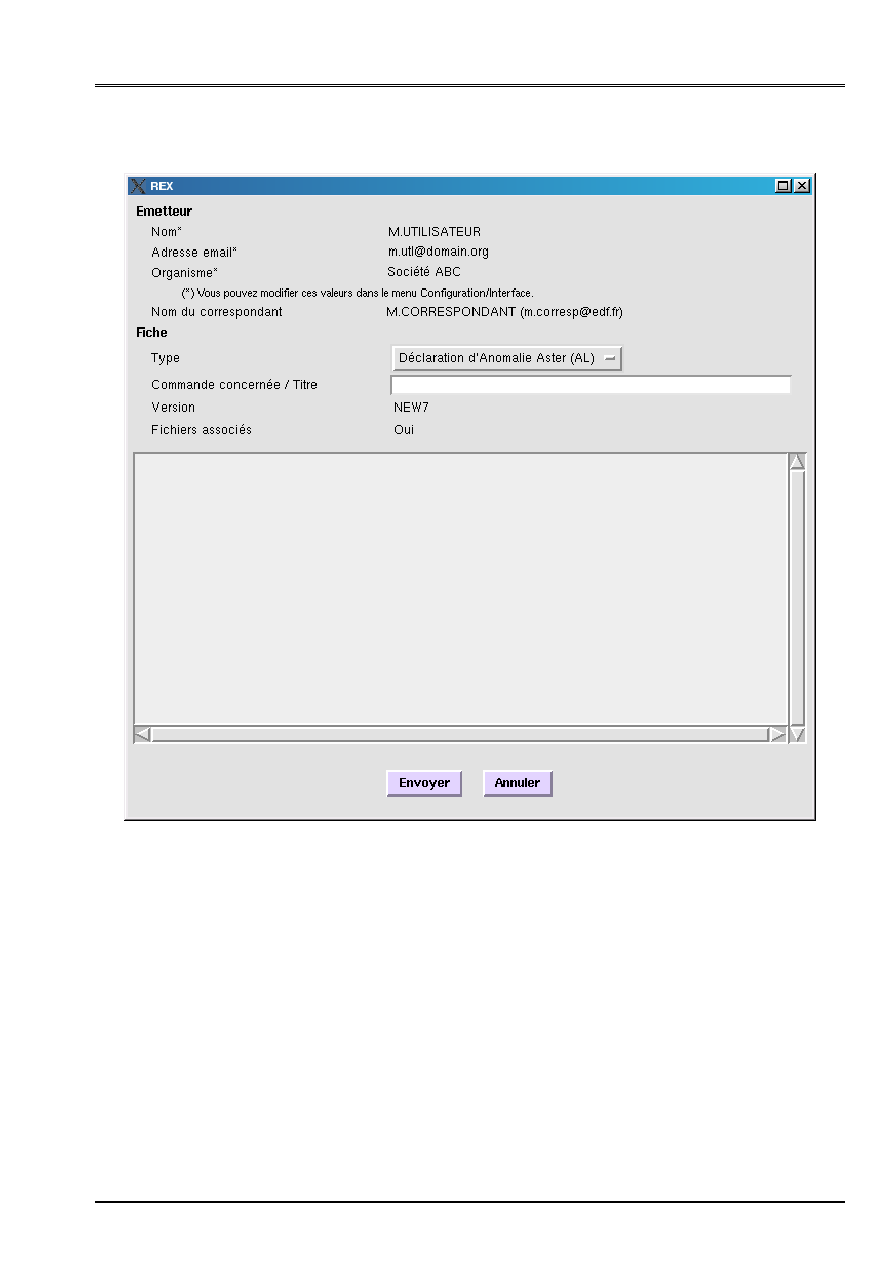
Code_Aster
®
Version
7.4
Titrate:
Interface access to Code_Aster: astk
Date:
05/04/05
Author (S):
COURTEOUS Mr.
Key
:
U1.04.00-C
Page
:
15/34
Instruction manual
U1.0- booklet: Introduction to Code_Aster
HT-66/05/004/A
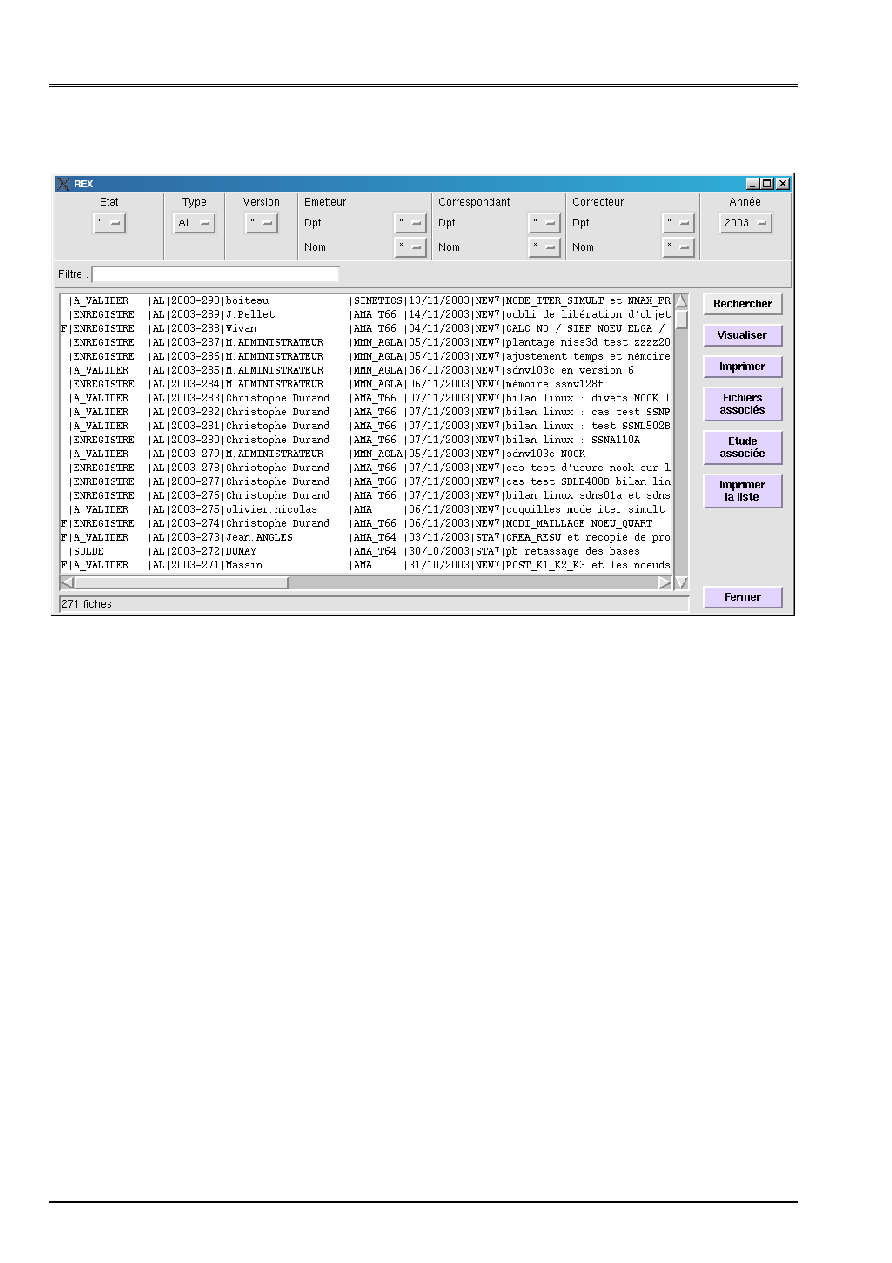
Code_Aster
®
Version
7.4
Titrate:
Interface access to Code_Aster: astk
Date:
05/04/05
Author (S):
COURTEOUS Mr.
Key
:
U1.04.00-C
Page
:
16/34
Instruction manual
U1.0- booklet: Introduction to Code_Aster
HT-66/05/004/A
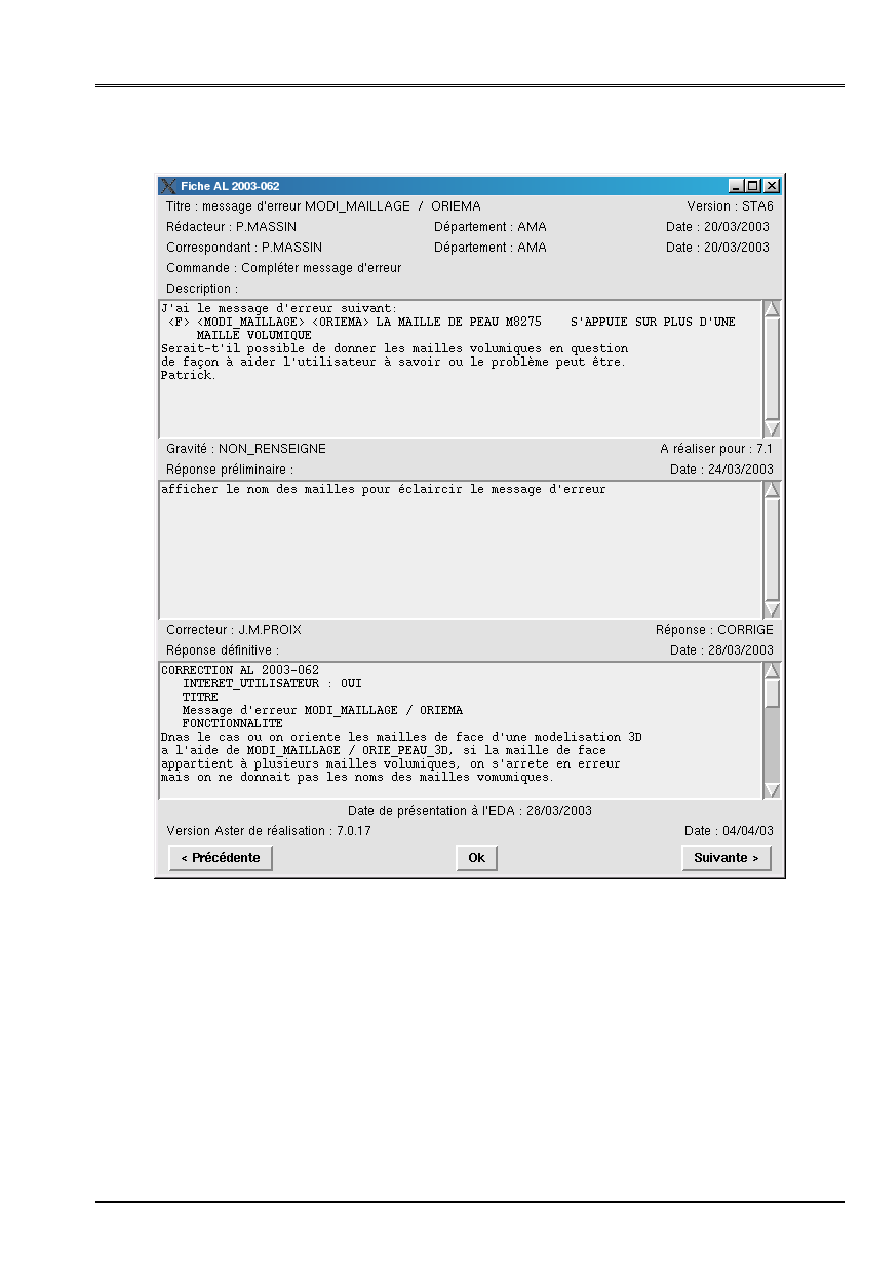
Code_Aster
®
Version
7.4
Titrate:
Interface access to Code_Aster: astk
Date:
05/04/05
Author (S):
COURTEOUS Mr.
Key
:
U1.04.00-C
Page
:
17/34
Instruction manual
U1.0- booklet: Introduction to Code_Aster
HT-66/05/004/A
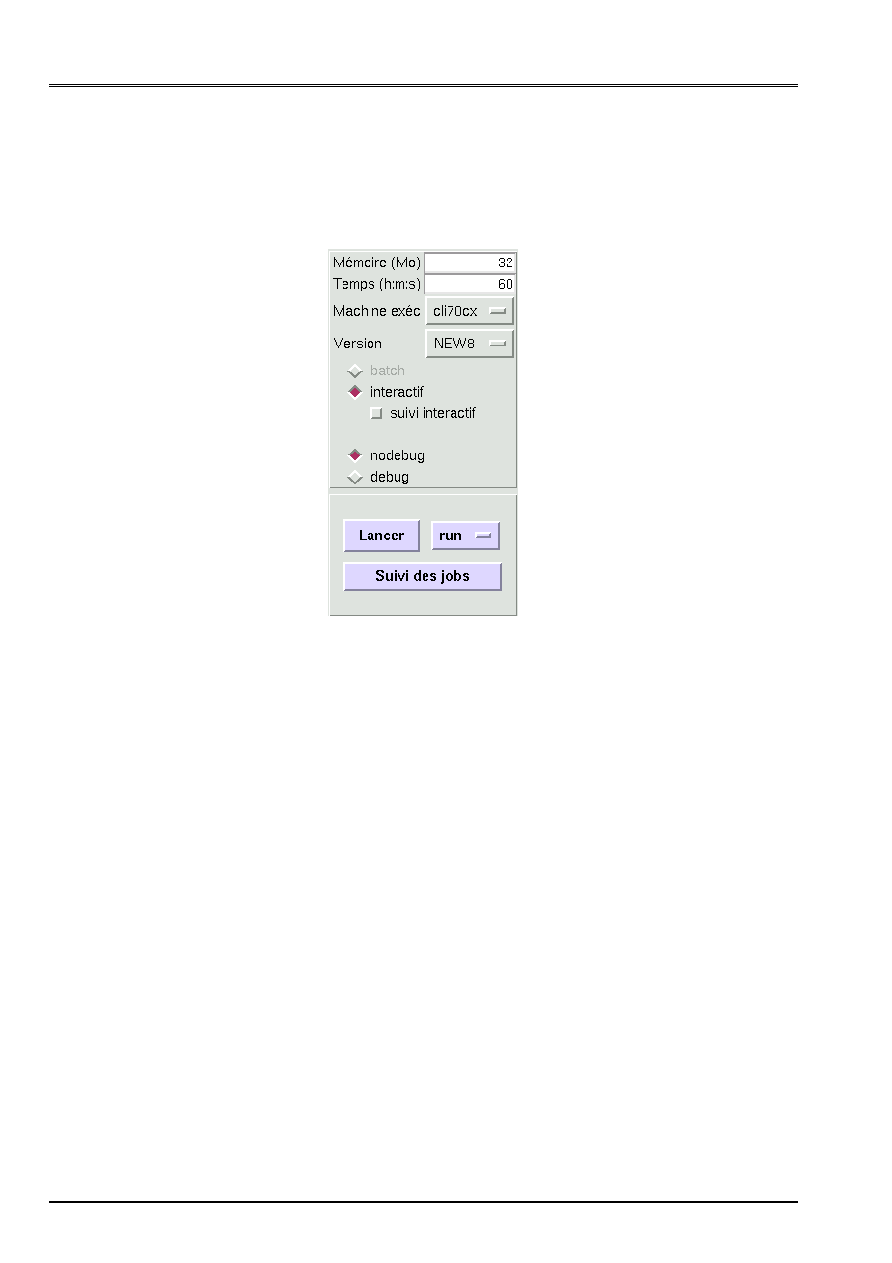
Code_Aster
®
Version
7.4
Titrate:
Interface access to Code_Aster: astk
Date:
05/04/05
Author (S):
COURTEOUS Mr.
Key
:
U1.04.00-C
Page
:
18/34
Instruction manual
U1.0- booklet: Introduction to Code_Aster
HT-66/05/004/A
2.3
Parameters of tender
The parameters of calculation are provided in the right part of the main window.
One defines the quantity of memory used for the job (in megabytes), the maximum time of calculation (in
seconds, minutes:seconds or hour:minutes:seconds).
One chooses on which machine calculation is carried out, the version of Code_Aster used, if calculation is
subjected in batch or interactive.
debug/nodebug: for a study without overload, one specifies which executable one wishes to use (under
reserve that both are available); at the time of an overload, one chooses to compile with or without
information of debug.
The button “Throw” carries out the actions according to the notched miters.
The button “Followed by the jobs” opens the window described afterwards.
Operating mode (for a STUDY):
During the launching of a study (with or without overload), a button of option is available to side
button “Throw”. Three modes of launching are available:
· “run”: carry out the study (conventional operation),
· “dbg”: launch the study by using the debugger,
· “pre”: prepare the index of work without carrying out the study.
When one selects “dbg” or “pre”, the mode “debug” is chosen by defect.

Code_Aster
®
Version
7.4
Titrate:
Interface access to Code_Aster: astk
Date:
05/04/05
Author (S):
COURTEOUS Mr.
Key
:
U1.04.00-C
Page
:
19/34
Instruction manual
U1.0- booklet: Introduction to Code_Aster
HT-66/05/004/A
2.4 Bar
of state
The area of text located all in bottom of the main window provides of aid when one navigate in
menus, or when the pointer passes to the top of the buttons of the interface.
During the launching of a calculation, the operations in progress are displayed here.
2.5
Follow-up of the jobs
This window provides information on the state of launched calculations, which appear in the form of one
list.
“To publish” breaks up into “File output” and “File error” which gives access to the messages
envoys by the job on the standard exit (stdout) and the exit of error (stderr). A double-click on one
job of the list also displays the file output.
“To remove” erases the selected jobs of the list, the files related to this job in the flashor and
calculation stops if the aforementioned is not finished.
“To bring up to date” questions the servers on which calculations are in progress. The check box allows
to reactualize automatically at a frequency defined in Configuration/Interface.
“To seek” allows to consult the last lines of the file message of a job in progress
of execution (it does not do anything on a finished job). One can use the area of text “Filters” not to display
that lines containing the character string indicated.
Innovation
One finds the same functions in the contextual menu which appears while clicking with
right button on one or more jobs. One can thus bring up to date one job among several
not finished.
Each line corresponds to a job, one finds 13 columns:
· The number of the job (in batch), number of the process in interactive
· The name of the job (name of the profile for a study, an overload, or name of function AGLA)
· Go back to tender
· Hour of tender
· State of the job (HANGS, RUN, SUSPENDED, ENDED)
· Diagnosis of job (OK, NOOK, <A>_ALARME, <F>_ERREUR, <F>_ARRET_ANORMAL…)
· Name of the tail in batch or “interactive”
· Time CPU of the execution Aster
· Login on the server of calculation used
· Address server of calculation used
· Machine of calculation (name of the node for a cluster)
· Version of astk
· Indicator interactive batch/
The diagnosis emitted by as_run appears in English, because it is envisaged to translate them overall, but
that was not carried out yet.
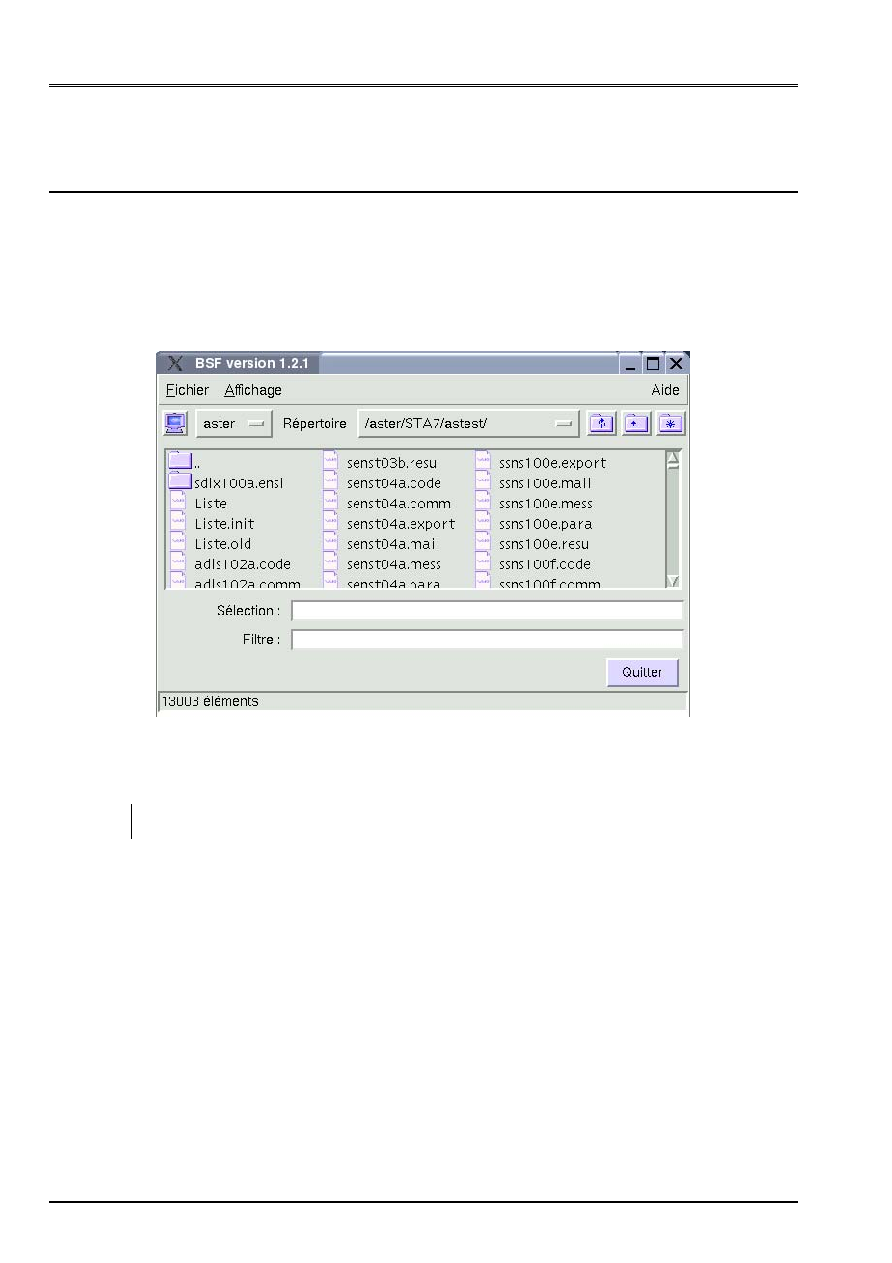
Code_Aster
®
Version
7.4
Titrate:
Interface access to Code_Aster: astk
Date:
05/04/05
Author (S):
COURTEOUS Mr.
Key
:
U1.04.00-C
Page
:
20/34
Instruction manual
U1.0- booklet: Introduction to Code_Aster
HT-66/05/004/A
3
Limp of selection of files: bsf
bsf is a tool delivered with astk which can only be launched. It is about a browser of files who allows
to navigate on the local machine, like a conventional browser of files, and also on
various configured distant servers.
bsf uses the configuration of the servers of astk, in particular the fields necessary to connection
(addresses IP, login) and controls to open a terminal or an editor.
The reading of the configuration is made only with the starting of bsf, if one modifies the configuration in
astk, it is thus necessary to close the bsf then to open it again.
Note:
bsf does not treat the file names and indices containing spaces (it results one from them
shift in the names and the types of the following objects).
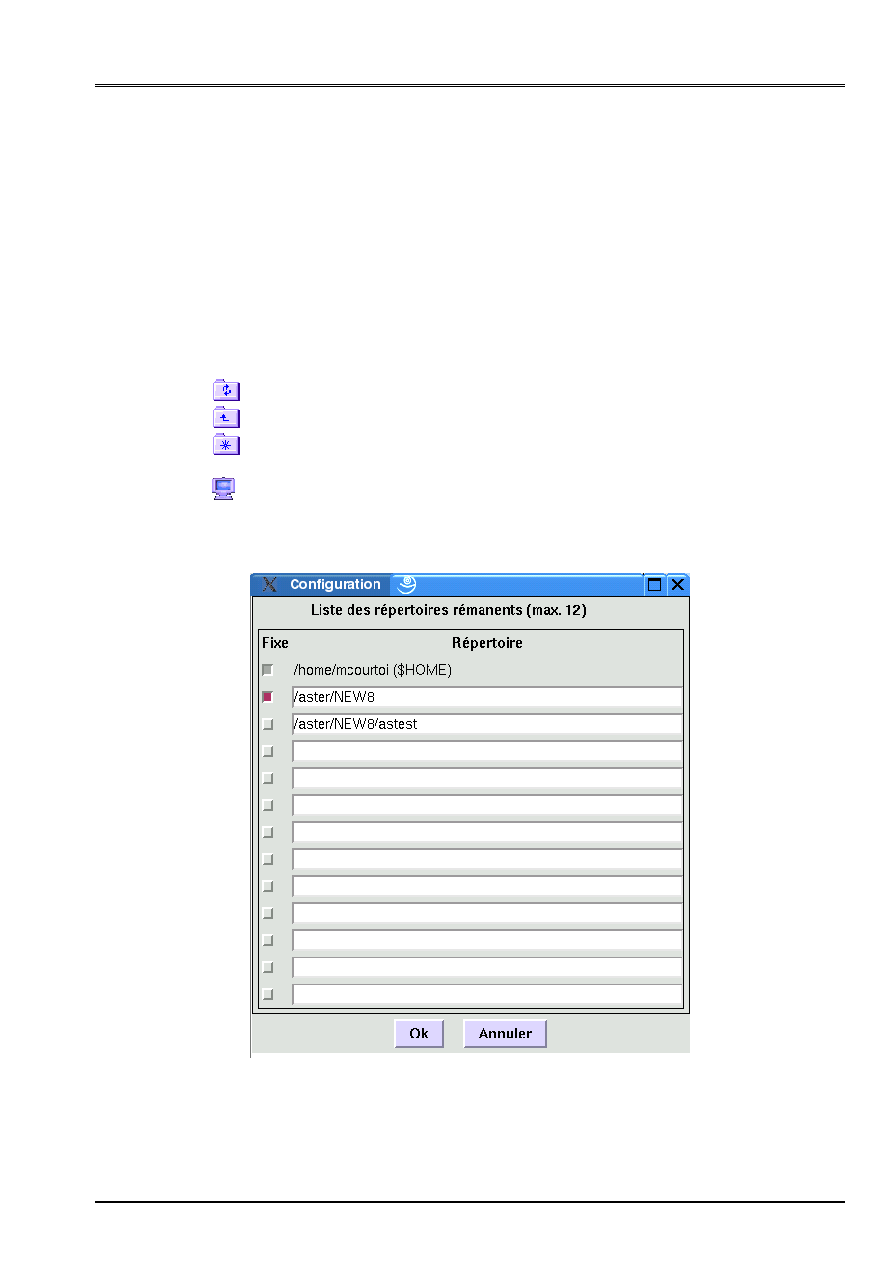
Code_Aster
®
Version
7.4
Titrate:
Interface access to Code_Aster: astk
Date:
05/04/05
Author (S):
COURTEOUS Mr.
Key
:
U1.04.00-C
Page
:
21/34
Instruction manual
U1.0- booklet: Introduction to Code_Aster
HT-66/05/004/A
3.1 Navigation
One finds two drop-down lists in the window of the bsf.
The first makes it possible to pass from a server to another, the second memorizes the list of the twelve
last indices where the user carried out an action (edition, copy…). The first input of this
list is “----- Direct -----”, which makes it possible to go directly in an index without traversing
the tree structure.
Generally, when the required index does not exist, one turns over in the definite HOME
for the current server.
One can configure this list and fix certain indices (so that they remain present in the list) in
clicking with the right button on the aforementioned (cf Appears 3.1-a).
·
: the contents of the current directory refresh;
·
: go up with the index relative;
·
: propose to create a new index in the current directory (and places itself in it
new index);
·
: open a terminal on the current server.
The bar of state gives indications on the significance of these buttons when the pointer of
mouse passes to the top.

Code_Aster
®
Version
7.4
Titrate:
Interface access to Code_Aster: astk
Date:
05/04/05
Author (S):
COURTEOUS Mr.
Key
:
U1.04.00-C
Page
:
22/34
Instruction manual
U1.0- booklet: Introduction to Code_Aster
HT-66/05/004/A
3.2
Small File and finely contextual
One finds certain inputs similar to the contextual menu of the files in the miters (see
[§2.2.1]): To open, Publish, Print, Open with…, Properties.
“To copy”: allows to copy one or more files/indices (shortened by CTRL+C).
“To cross”: idem To copy, except that the original files will be removed (shortened by CTRL-X).
“To stick”: carry out indeed the copy or the displacement of the files (shortened by CTRL+V).
“To remove”: erase the selected files/indices.
“New file/New index”: respectively allow to create a file or one
index in the current directory.
“To carry out a control”: give the possibility of carrying out a control in the index
running, the current selection is proposed on the line of control, it is necessary to choose one of the shells
available on the server.
3.3 Menu
Display
One can choose to display or not the files known as hidden (starting with “.”) by notching the box
envisaged.
bsf displays the indices then the files, one alphabetically can Trier of the name or in
function of the date in the normal or opposite order by modifying the options of the menu.
The preferences of display are preserved if one selects “To record the preferences”.

Code_Aster
®
Version
7.4
Titrate:
Interface access to Code_Aster: astk
Date:
05/04/05
Author (S):
COURTEOUS Mr.
Key
:
U1.04.00-C
Page
:
23/34
Instruction manual
U1.0- booklet: Introduction to Code_Aster
HT-66/05/004/A
4 Configuration
The first time that the user launches the interface, it has a configuration by defect which was
defined at the time of the installation. The configuration is then stored in the index $HOME/.astkrc.
If the user wants to return to the configuration of origin, it must erase this index and start again astk.
Notice n°1
With each time one defines a control to be carried out (final, editor…), it is
advised to show the absolute way (since the root) to prevent that the control
that is to say not found if the variable $PATH is incorrect.
Notice n°2
In general, astk supplements the controls which need to display windows with
the argument “- display SCREEN”, where SCREEN is the current price of the variable
$DISPLAY. If the control used does not accept this argument, it is enough to specify
good syntax with the code @D which will be replaced by the current variable of
$DISPLAY (for example: mon_editor - display=@D, cf Small Tools).
One can check the current price of $DISPLAY, small Aide/Fenêtre of the messages:
astk indicates in the first lines for example:
<INFO> Display of the applications on mach00.domain.org:0.0
It is this value which will be provided to the supposed distant machines to display a window
on the machine customer.
The server part of astk (ASTK_SERV) included tools simplifying certain tasks of the developers
like the consultation of the source code or the update of a local version of development.
The file $HOME/.astkrc/config thus contain two information necessary to contact
machine of reference: the complete name of this server and the login of the user. This last must be
defined in this file to avoid following alarm:
<A>_ALARM remote connection may fail:
devel_server_user not defined in/home/xxxxxx/.astkrc/config
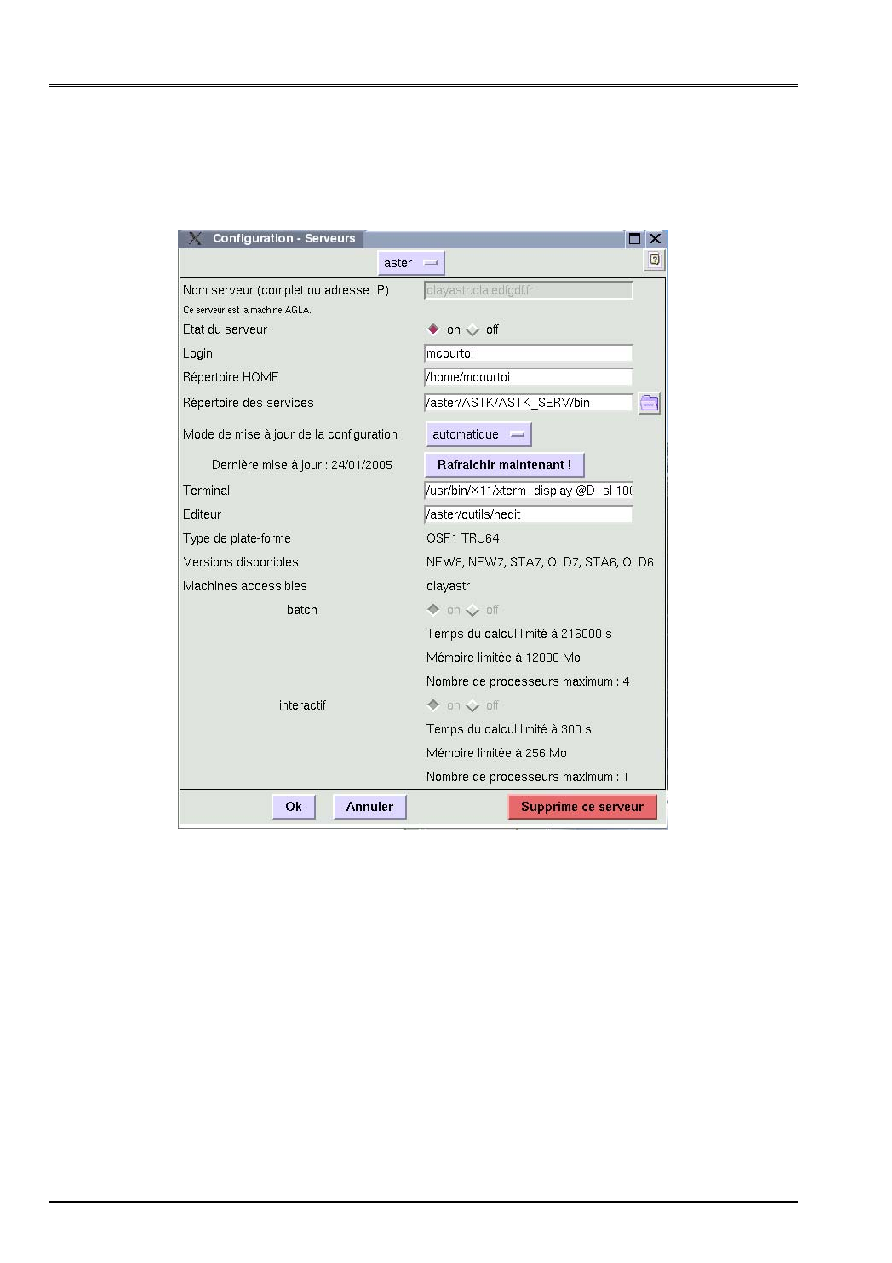
Code_Aster
®
Version
7.4
Titrate:
Interface access to Code_Aster: astk
Date:
05/04/05
Author (S):
COURTEOUS Mr.
Key
:
U1.04.00-C
Page
:
24/34
Instruction manual
U1.0- booklet: Introduction to Code_Aster
HT-66/05/004/A
4.1 Servers
One reaches the window of configuration by small Configuration/Serveurs.
Configuration/Servers
The first button makes it possible to pass from a server to another and to add a “New server”.
The fields are:
· Complete name or addresses IP: it is about the name of the server on the network; one can indicate sound
complete name with the domain name (for example: linux.labo.univ.fr) or its address IP (by
example: 156.98.254.36).
· State of the server: one can put on “off” a temporarily inaccessible server.
· Login: identifying with which one connects oneself to the server.
· Index HOME: index by defect when one arrives on this server with the bsf.
· Index of the services: index where are installed the services on this server (to indicate it
complete path, for example: /aster/ASTK/ASTK_SERV/bin), to leave vacuum for one
file server.
· Mode of downloading of the configuration: no (for a file server), manual (it
is necessary to click on the button “To download now” to recover the Aster configuration of
server), automatic (astk questions the server with starting every 30 days).
· Last downloading: date from the last update of information of configuration.
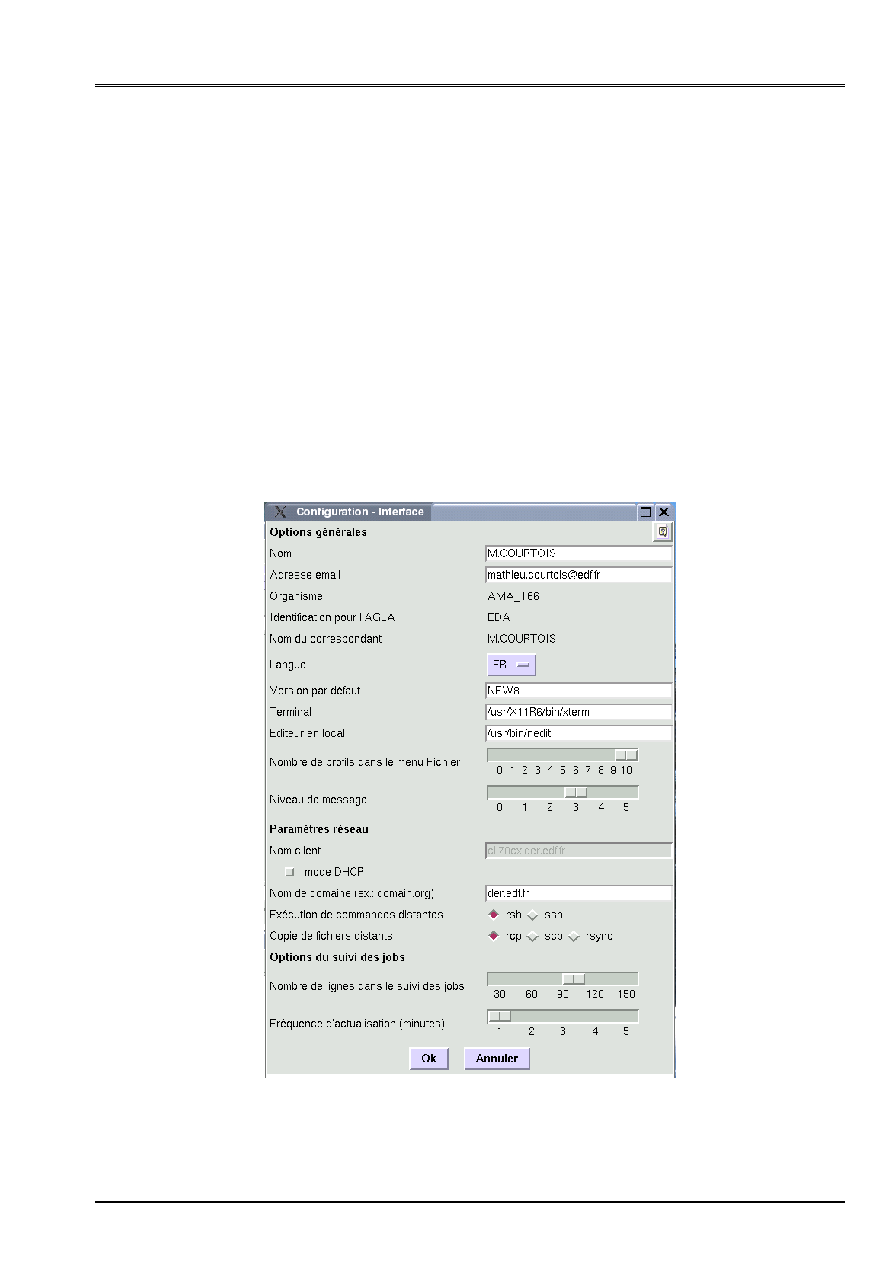
Code_Aster
®
Version
7.4
Titrate:
Interface access to Code_Aster: astk
Date:
05/04/05
Author (S):
COURTEOUS Mr.
Key
:
U1.04.00-C
Page
:
25/34
Instruction manual
U1.0- booklet: Introduction to Code_Aster
HT-66/05/004/A
· Terminal: order to open a terminal on the server. This makes it possible to open a window
controls on the server when the bsf is used, and to follow a calculation (it interactivement
terminal must accept the option E to carry out a control, xterm is appropriate).
· Editor: editor text (for example, nedit). The procedure of installation chooses an editor
among (and in this order): nedit, xemacs, emacs, xedit, VI.
The following values are turned over by the service as_info (nothing for a file server) and
thus depend on the configuration of the server part of astk:
· Type of platform.
· Versions available
· Accessible machines: list accessible nodes of calculation since this server.
· Interactive batch/: specify if the server accepts launching in batch, interactive and provides them
limits in memory, time CPU, a number of processors fixed on the server.
Seul LSF is supported like software of management of batch, the support of PBS is still
incomplete and experimental.
4.2 Interface
One reaches the window of configuration by small Configuration/Interface.
Configuration/Interface

Code_Aster
®
Version
7.4
Titrate:
Interface access to Code_Aster: astk
Date:
05/04/05
Author (S):
COURTEOUS Mr.
Key
:
U1.04.00-C
Page
:
26/34
Instruction manual
U1.0- booklet: Introduction to Code_Aster
HT-66/05/004/A
This window makes it possible to inform personal information of the user, to choose the language
used by the interface.
For those which have access to the machine of reference, authority AGLA is displayed (EDA for
developer, UTL for user…). For the EDA, the organization and the name of the agent are
automatically filled. The users must do it themselves.
Then, one finds the version which will be selected by defect, the controls to reach one
terminal and an editor (as for the servers).
“A Many profiles in small Fichier” make it possible to preserve the name of the NR the last open profiles
so as to point out them quickly.
“Level of message” indicates the level of details of the messages written in the window of
messages of the menu Helps. Niveau=0: only the messages <INFO> and <ERREUR> are written;
higher levels allow debugger the behavior of the interface. Level 1 is advised, it
allows to see the error messages being able to appear at the time of the problems of communication with
distant servers.
One must then specify the domain name network of the machine. For example, domain.org if it
complete name of the machine is mach00.domain.org. If the domain name is left empty, one
message of alarm is displayed with starting because the distant machines are likely not to be able
to contact the local machine mach00 with its short name. The name of the machine such as it will be used
by the distant machines is indicated in the field Nom Customer. If mode DHCP is active, it is
in this field which one can indicate address IP of the local machine.
For the follow-up of the jobs, one can choose the number of displayed lines when the file is visualized
output in the course of job (button “To seek”), and the frequency of updating of the list.
4.3 Tools
One selects the tool to be configured with the drop-down list, or a new tool is added.
Standard tools are predefined (tiny the/capital ones are taken into account in the names
tools). The tools are necessarily carried out on the machine “Room” (where the interface is launched).
In general, the tools are launched either on a file of a miter (STUDY, TESTS or OVERLOAD),
maybe on a file when one traverses the filing system with the bsf.
One defines simply the line of control necessary to the launching of a tool (absolute path
advised), one can place the codes @F, @R, @f, @D in the line of control (see [§ 2.1.3]) for
to correctly pass a file to the tool. One can put these codes between brackets to be able
to launch the tool alone, without file in argument.
Types of files can be associated the tool. The type taken into account to launch the tool is
extension when one traverses the files with the bsf, the type of the drop-down list when it acts
of a miter.
One can choose if the tool is usable on a distant file. In this case, astk is given the responsability to bring back it
file in question about the local machine in a temporary index, of launching the tool, then
to redeposit the file on the distant server (even if it were not modified by the tool).
4.4 Impression
The controls of impression are defined by small Fichier/Impression.
On the same principle that the tools, one defines any ordering of impression (LP, lpr,
a2ps…) who contains the code corresponding in the name of the file (@F, to see [§ 2.1.3]). @P is replaced
by the name of the file of impression.
Here a conventional list of control using GNU a2ps:
Format 2 columns/page:
a2ps - P @P - 2 - l82 --footer --print-anyway=yes --sides=tumble @F
Format 136 characters/line:
a2ps - P @P - R - l136 --columns=1 --footer --print-anyway=yes --
sides=tumble @F
“Transparent” format:
a2ps - P @P - R --columns=1 --print-anyway=yes --sides=simplex @F

Code_Aster
®
Version
7.4
Titrate:
Interface access to Code_Aster: astk
Date:
05/04/05
Author (S):
COURTEOUS Mr.
Key
:
U1.04.00-C
Page
:
27/34
Instruction manual
U1.0- booklet: Introduction to Code_Aster
HT-66/05/004/A
5
How to make a study?
In this paragraph, one describes stage by stage how to use astk to make a study.
The study consists in calculating the response in bending of a bent piping. One has the elements
following:
· A command file Aster: demo01a. COM
· The description of the geometry carried out with Gmsh: demo01.geo
· Mesh built by Gmsh: demo01a. msh
The following results are produced:
· A file of mesh Aster: demo01a. mall
· A file result with the format Gmsh (fields of displacements, stresses…) : demo01a. pos
· Conventional files of message and Aster result: demo01a. mess and demo01a. resu
In the example, one places all the files in the index/home/tutorial/demo01.
Note:
In the case of a study with several command files, all the files must be
of type “COM”, associated the logical unit 1 and it is the extension which determines the command
of execution: .comm, then .com0, .com1,…, .com9 (there can be holes).
5.1
Creation of the profile
One launches the interface which opens on a virgin profile, or if astk is already launched, one chooses
New file/in the menu to create a new empty profile.
One places oneself in the miter STUDY.
5.2
Selection of the files
5.2.1 Definition of a basic path
In the miter STUDY, one chooses a basic path to simplify the access to the files.
One clicks on the icon
, one chooses the index/home/tutorial/demo01.
5.2.2 Addition of existing files
One adds the command file while clicking on
, the selection of file opens directly
in the basic path which one has just defined. It only remains to select the file demo01a. COM
(double-click or simple click + ok), and the file appears in the list. Let us note that astk identifies the type of
this file starting from its extension “COM”, the logical number of unit is positioned to 1, the box
“D” (given) is notched.
One makes in the same way for the file of mesh to the format Gmsh (demo01a. msh). astk recognizes
the extension “msh”, the logical number of unit is positioned to 19, the box “D” is notched.
5.2.3 Addition of files…
Except if an execution already took place, the files results do not exist yet, one thus cannot
to add by traversing the tree structure.

Code_Aster
®
Version
7.4
Titrate:
Interface access to Code_Aster: astk
Date:
05/04/05
Author (S):
COURTEOUS Mr.
Key
:
U1.04.00-C
Page
:
28/34
Instruction manual
U1.0- booklet: Introduction to Code_Aster
HT-66/05/004/A
5.2.3.1… while inserting a blank line
The mesh with the Gmsh format will be read again and converts in the command file Aster by
order PRE_GMSH in mesh with the Aster format. One can recover this mesh by adding one
file of the type “mall” on the logical unit 20.
One clicks on
, a line is added in the list. One chooses the type “mall” in the list (what has
for effect to position the logical number of unit to 20). The name is indicated
/home/tutorial/demo01/demo01a. mall or demo01a. mall or./demo01a. mall (since one
can indicate the name of the file into relative compared to the basic path). The file is produced by
the execution, one thus notches the box “R” (result) and one strips “D”.
Notice
Control PRE_GMSH uses by defect numbers 19 and 20 with
inputs/outputs, if one modifies the command file to read again or write the files of
mesh on other units, it is necessary to be coherent for the numbers indicated in astk.
5.2.3.2… with “Default value”
One could continue thus to add the other files, but one will use the function “Value by
defect “for the following files. This function uses the name of the profile astk to build them
default values (see [§ 2.2.1]/Finely contextual), one thus will record the profile.
One chooses Enregistrer under… in small Fichier, one goes with the navigator in the index
/home/tutorial/demo01, and in the line Selection, one types demo01a (the extension .astk is
automatically added).
Let us note that the title of the main window of astk gives the name of the current profile. The title is
now: ASTK version 1.2.1 - demo01a. astk -/home/tutorial/demo01
One inserts a blank line while clicking on
, one chooses the type of file “pos”, then one clicks with
the right button in the box of the one and file name chooses “Default value”: astk builds one
file name starting from the name of profile (by withdrawing the extension) and of the type “pos”, is
/home/tutorial/demo01a/demo01a. pos. Moreover, astk tries to substitute the basic path
for more legibility, one sees as follows: ./demo01a. pos.
The box “R” was notched, and the logical number of unit fixed at 37. Let us suppose that in the file of
order, one indicated:
IMPR_RESU (UNITE=30,…)
one thus modifies the logical number of unit consequently, it is enough to click on the old value, of
to erase and to type 30. Only two digits are displayed in this box, to avoid the errors, astk
check that the numbers of logical unit lie between 1 and 99.
In the same way, one adds a file of the type “mess” and one of type “resu” in this manner (of leaving them
numbers of logical unit per defect).
5.2.4 To remove a file
To remove a line of the list of the files, it is enough to select it while clicking in the area where
one indicates the name of the file and to click on the icon
.
Note:
Only the reference to this file in the profile astk is forgotten, the file itself is not
erased!

Code_Aster
®
Version
7.4
Titrate:
Interface access to Code_Aster: astk
Date:
05/04/05
Author (S):
COURTEOUS Mr.
Key
:
U1.04.00-C
Page
:
29/34
Instruction manual
U1.0- booklet: Introduction to Code_Aster
HT-66/05/004/A
5.3
Launching of calculation
The files given and results are selected, one adjusts the parameters of calculation (see [§ 2.3]), and
one clicks on the button “Throw”.
One takes care to notch the box which is just beside STUDY to announce that one wishes
to use the contents of this miter… if not interfaces it answers us “Nothing launching! ”.
If the profile were not recorded yet, the interface requires to choose a place and a name for it
profile (see [§ 5.2.3.2]).
astk calls the service which carries out calculation, and transmits to the Follow-up jobs (asjob) the number of the job
(number of the process in interactive) and other information which will make it possible to follow advance
calculation. The initial state of calculation east HANGS (on standby), when calculation starts, it becomes RUN, then
ENDED when it is finished (other states are possible in batch). The button “To bring up to date” calls
the service which refreshes the state of calculations in progress.
When calculation is finished, one can consult the output of the job while double-clicking on the job, or by
To publish/File output.
5.4
Consultation of the results
One can consult the files results simply while double-clicking on their name, which opens one
text editor for the files “mess” and “resu”; on the file of result to the Gmsh format,
“pos”, that causes to open this file in Gmsh directly. One visualizes the deformation thus and
isovaleurs (provided Gmsh were installed, and that “pos” is in the types of files
associated Gmsh, to see [§ 4.3]).
5.5
Use of the tools
One can also use astk and the fact that one can freely define tools in it to gather in
a profile all files necessary to a study even if those are not directly used by
Code_Aster.
In this example, demo01a. geo is a file that Code_Aster cannot read again; it contains
description of the geometry, Gmsh uses it to create the mesh (.msh).
One can nevertheless insert it in the profile (button
), to affect an unspecified type to him (“libr” by
example) since it will not be used during the execution (boxes D, R not notched).
One can directly open the geometry by making Ouvrir with…/Gmsh (right click on the name of
file), to modify the geometry or the parameters of the mesh, to re-mesh and record the mesh.
One can then start again calculation on the new file demo01a. msh.
Obviously, this is not limited to Gmsh; one can use other tools (mailleurs, tool of
postprocessing, graph plotter…) directly since astk and to reach all the files thus
of a study since a profile with the adequate tool.

Code_Aster
®
Version
7.4
Titrate:
Interface access to Code_Aster: astk
Date:
05/04/05
Author (S):
COURTEOUS Mr.
Key
:
U1.04.00-C
Page
:
30/34
Instruction manual
U1.0- booklet: Introduction to Code_Aster
HT-66/05/004/A
6
How to carry out an overload?
One considers in this paragraph that the user is familiar with handling of the lists of
files in the miter STUDY.
An overload consists to add or modify part of Code_Aster and to use it to carry out one
study. The objective of an overload is to produce executable, a compiled catalog of controls
and/or a catalog of elements. One can also overload the methods python defined by Aster, in
this case, the sources is recopied in the index of execution (it does not have there a receptacle object of
overloaded files python).
One places oneself in the miter OVERLOADS.
6.1
Addition of the sources
One proceeds like adding files for a STUDY. One can select is a file,
that is to say an index. It is often clearer and more practical to place its source files in
indices.
If one adds an index in the list of the sources (left higher the miter OVERLOADS)
type “F” (files FORTRAN), all the files whose extension is .f will be compiled and used to make
new executable.
6.2
To define the results of the overload
Files C (standard “C”) and FORTRAN (standard “F”) make it possible to build executable: type “exec”.
The catalogs of controls “capy” make it possible to build a catalog of controls
compiled: type “cmde” (index containing the files cata.py and cata.pyc).
The catalogs of elements, options and sizes “cata” are used to produce a catalog
compiled elements: “it”.
6.3
Taking into account of the overload
So that the data well informed in the miter OVERLOAD are taken into account, it is necessary to notch
the box located just on the right of the button OVERLOADS (the miter OVERLOAD is always notched in
this paragraph).
One needs a receptacle in result absolutely corresponding to the data sources (“D” notched).
If there are indices “C” and/or “F” in “D” onnée, one needs a “exec” in “R” ésultat; of
even for “capy” with “cmde” and “cata” with “it”.
One can prepare the overload independently of the study (advised) or make the overload and
to launch the study in the tread.
6.3.1 To prepare the overload alone, then to launch a study
To prepare the overload alone:
· to strip the miter STUDY
· to put the sources in “D” onnée
· to only put the corresponding receptacles in “R” ésultat
· “To launch”.
The overload builds the results (executable, catalogs…) starting from the data (sources).
Launching of the study by using this overload:
· to notch the miter STUDY
· to strip the indicator “D” for the sources
· to put the réceptables in “D” onnée only
· “To launch”.

Code_Aster
®
Version
7.4
Titrate:
Interface access to Code_Aster: astk
Date:
05/04/05
Author (S):
COURTEOUS Mr.
Key
:
U1.04.00-C
Page
:
31/34
Instruction manual
U1.0- booklet: Introduction to Code_Aster
HT-66/05/004/A
The products of the first stage are then used as data to launch the study.
Caution: Not to strip OVERLOAD, if not the study will be launched with the standard version
not overloaded.
It is rare that compilation succeeds with the first test, by separating the two tasks, one sees
immediately if compilation occurs badly, or if the executable one is not produced.
6.3.2 To make the overload and to launch the study at the same time
To connect the two stages automatically:
· to notch the miter STUDY
· to put the sources in “D” onnée
· to put the corresponding receptacles in “D” onnée and “R” ésultat
· “To launch”.
In the event of problem of compilation, it may be that executable is produced without taking in
count part of the data sources. It is thus necessary to look at the output attentively of
compilation. For that, the step of the preceding paragraph is advised.
7
How to launch a list of tests?
It is necessary to approach this point after the two precedents. Indeed, throw a list of tests does not have
of interest that to validate an overload is with respect to nonthe regression of the functionalities
original of the code, that is to say on a whole of case testing a new functionality.
To use this possibility, it is necessary to notch the box located just on the right of the button TESTS (what
strip STUDY automatically). In the majority of the cases, one uses an overloaded version, therefore
in this case the miter OVERLOAD is also notched.
Notice n°1
It is absolutely necessary to prepare the overload independently of the launching of test
as with the § “Preparing the overload alone, then to launch a study”. One prepares
overload, then one launches the tests with the results of this overload.
Notice n°2
On the machine of reference, the launching of a list of tests must be made
only in batch.
The data are very simple, one provides a file of the type “list” (see [§ 1]); “rep_test” indicates where
are the files necessary to the launching of the tests (“given” of the tests: .comm,
.mail…) ; “resu_test” makes it possible to write the results of the tests in another index.

Code_Aster
®
Version
7.4
Titrate:
Interface access to Code_Aster: astk
Date:
05/04/05
Author (S):
COURTEOUS Mr.
Key
:
U1.04.00-C
Page
:
32/34
Instruction manual
U1.0- booklet: Introduction to Code_Aster
HT-66/05/004/A
8 Questions
frequent
“Nothing occurs when one tries to launch a calculation, to publish a file or to open one
terminal on a distant server “or “Code return = 2, Profiles Copy failed in the window
messages with the launching of a calculation “
It is probable that the local machine cannot communicate correctly with the server
distant. Communications using protocol CCP/rsh, the files .rhosts on the local machine
and on the distant servers must be correctly well informed. If one uses protocol SCP/HS, it
is necessary that the private and public keys are coherent.
One can check it by leaving astk, and by starting again it in this manner:
astk --debug 0 - check (--debug 0 is used to limit the impressions)
To attentively see information which is printed. astk provides information on the variable
of environment DISPLAY (to check that it is correctly defined), and tests connection between
machine where is launched astk and distant servers. In the event of problem of connection with one
server, astk suggests an amendment of the file .rhosts of the target machine.
“When a calculation in batch is subjected, there is the message: The number of the job and the class do not have
not been able to be recovered “
Time or the required memory is probably beyond the limits of the classes of work. See
in the window of the messages, there is probably a message of the manager of batch of the style
“Boat exceed queue' S hardware limit (S)”.
To decrease time or the memory, or explicitiment to choose a class batch which agrees in
additional options.
“While clicking on Default value the file name remains empty”
This function uses the name of the profile to determine a default value, it is necessary to record the profile
before being able to use this function.
“On the machine of reference: the behaviors in batch and interactive are different”
It is possible. In batch, Code_Aster is launched by scripts of the AGLA, in interactive, one rests on
as_run. To announce in a “AO” the differences.

Code_Aster
®
Version
7.4
Titrate:
Interface access to Code_Aster: astk
Date:
05/04/05
Author (S):
COURTEOUS Mr.
Key
:
U1.04.00-C
Page
:
33/34
Instruction manual
U1.0- booklet: Introduction to Code_Aster
HT-66/05/004/A
Appendix 1 Use of the service as_run (of ASTK_SERV)
The reading of this chapter is reserved to the users who wish to launch Code_Aster “to the hand”, without
to use the interface and with those which installed and maintain a version local.
When one uses the interface astk for launching calculations, the aforementioned as a customer calls upon
services suggested by a server which can be on the same machine or a distant machine (in
the case where the server is distant, there are exchanges of files and a Shell control through the network
(protocol rsh or HS) that we do not detail here).
Several services are called by the interface:
as_info: recover information of configuration of the server: versions and machines of
calculation available, limits in interactive and batch;
as_actu: recover the state of a calculation in progress or finished;
as_tail: recover the last lines of the output of calculation (stdout, left standard);
as_del: stop a calculation in progress and/or removes the files of the flashor associated with this calculation;
as_edit: open the file output of a calculation (file .o of the flashor) or error (file .e) in one
editor;
as_exec: launch the actions indicated in the profile in argument (file of the .export type).
as_run is a service called by as_exec within the framework of an execution via the interface, it is limited to
to launch an execution of Code_Aster, with or without overload, a simple study or a list of tests.
The options of as_run are given while typing: as_run --help, one obtains:
use: as_run action [options] [arguments]
Functions:
- Return the hand subroutine off has code_aster command:
as_run --getop [options] control [.capy]
- Return current release number off the development version:
as_run --getversion [options]
- Show has source slips by: FORTRAN, C, python, capy, cata, histor gold test:
as_run --show [options] obj1 [obj2…]
- Copy has source slips by in current directory:
as_run --get [options] obj1 [obj2…]
- Build has code_aster version (executable, libraries, catalogs):
as_run --make [--version_dev=VERS]
- Perform one gold several updates off has version development:
as_run --update [options] fich1.tar.gz [fich2.tar.gz…]
- Download available updates from has server and apply them to the current
development version:
as_run --auto_update [options]
- The execution described by the Carries out profiles (default action):
as_run --run [options] profiles
options:
--version show program' S version number and exit
- H, --help show this help message and exit
- v, --verbose print status messages
- G, --debug print debugging information

Code_Aster
®
Version
7.4
Titrate:
Interface access to Code_Aster: astk
Date:
05/04/05
Author (S):
COURTEOUS Mr.
Key
:
U1.04.00-C
Page
:
34/34
Instruction manual
U1.0- booklet: Introduction to Code_Aster
HT-66/05/004/A
- F, --force force operations which edge Be cached (download,
compilation…)
--remote_shell_protocol=REMOTE_SHELL_PROTOCOL
remote protocol used for Shell commands
--remote_copy_protocol=REMOTE_COPY_PROTOCOL
remote protocol used to Copy files and directories
--editor=EDITOR editor command
--devel_server_user=DEVEL_SERVER_USER
login one the development server (name/IP address is
usually set in ASTK_SERV/conf/config)
Options for maintenance operations:
--vers=VERS Code_Aster version to used
- has, --Al get Al the files off the test
--version_dev=VERS development version off Code_Aster to update
- L, --room files will not been searched one has server drank one the
room machine
--nolocal force remote files search (reverse off --room)
Additional precise details:
· One can create a link towards as_run for any action to simplify the call (this is
especially useful for the actions get, show and getop which one often calls):
get - > as_run
One can then use get fichier.f instead of as_run --get fichier.f
· When one recovers a source file with get, show or getop, the aforementioned is put in
/tmp/astk_ `login `/cover. If for the same file again is asked, the aforementioned is taken
directly in this index except if the option --force is activated; the files which have more one
day are automatically removed cover.
· --room/--nolocal: these two options make it possible to pass in addition to the value defined in
file of configuration. If the mode by defect is to seek the files locally, one can use
--nolocal to force search on a distant machine (it is in particular useful for
to seek the updates of Code_Aster on the www.code-aster.org server).
Conversely, if one systematically recovers the files on a server of development in
network, one must use --room to visualize source files installed on the machine
local.
· The main file of configuration is xxxx/ASTK/ASTK_SERV/conf/config (where xxxx are it
main index of installation of Aster), the user can define certain values in
$HOME/.astkrc/config (where $HOME is the index by defect of the user), in particular it
name of user to use on the distant server (devel_server_user) to avoid an alarm with
each launching of as_run.
· --version_dev is used by the actions make, update and auto_update. Whereas --towards
is used by get, show and getop.

































